Great Britain Pavilion
The entrance to Great Britain's pavilion was on a moving turntable through a damp cave. For three minutes ghosts of kings and shadows of armies accompanied by sounds of battles were projected on rocks along the walls. Dim spectres of conquests flowed through ten British dynasties; Norman, Plantagent, York and Tudor. There were flowing pennants and bloody shields, Vikings and Roman legionnaires, angry peasants and triumphant kings. Below, at the base of the rocks, was a dark stream where the ghosts of Drake, Nelson and St. George were seen. Again the trumpets sounded and swords clashed as armies meet. The show, "Shaping the Nation" was brilliant. At the end you didn't know what king had killed his brother, or which invading army had won or not, but the visitor gained an impression of the tapestry of British history.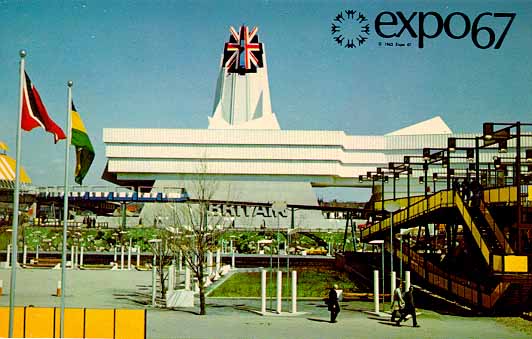
| Britain's pavilion was dominated by a 200 foot high tower and a 3-D Pop-Art Union Jack flag. The rest of the pavilion was a sprawling white windowless building. |
The main part of the British pavilion was a sprawling white windowless building, that jutted up from the ground and protruded over the surrounding moat. Past the open courtyard, 200 feet above, was the top of a tower where a sculptured Union Jack thrust from the jagged opening. The tower, was so designed by architect Sir Basil Spence, to signify Britain's unfinished business in the world.
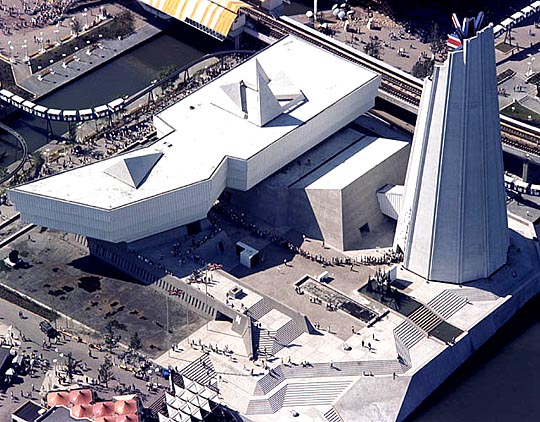
| Aerial view of the Great Britain pavilion. |
An escalator lead up from the "cave of history" to the light of the "Genius of Britain", an area which reached the peak of the tower. In the center, a huge jet engine pointed like a rocket towards the blue-and-black mosaic on the ceiling 50 feet above. All around the engine, on two levels, were portraits of Britain's greatest men accompanied by descriptions of their achievements.
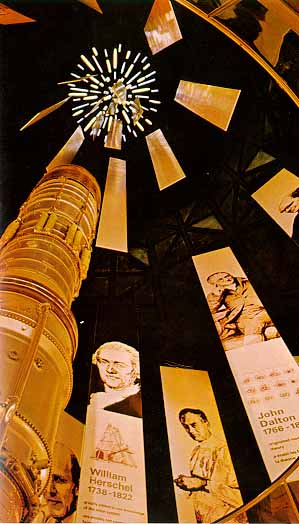 |
Genius of Britain showed portraits of Britain's greatest men surrounding a huge Olympus jet engine pointed at the ceiling. |
"Britain Today," the third section, described the British people as they are today, not as they were, or how the world perceives them. Britons buy clothes, get married, fall in love when they are young, love the royal family when they are old, and drink tea all their lives. They wash the car, decorate the house, eat fish and chips off newspaper and listen for the weather forecast. They read more books and newspapers than any nation on earth. They have a class system that is slowly crumbling.
The room was filled with displays; a little old woman sitting happily alone in a corner, a cat on her lap, her faced turned to the telly, and her teapot beside her. Nearby was the sound of the Beatles and the colors and shapes of mini fashions. A minicar was painted as the Union Jack and long curved eyelashes nearly covered its headlights. Eton boating songs played behind models of four oarsmen, each from a different social background. Circular illuminated signs and short sound-tracks poked fun at everything. A walk around the hall was like walking through one of Britain's new towns, with a chance to peer into the homes and lives of its inhabitants.
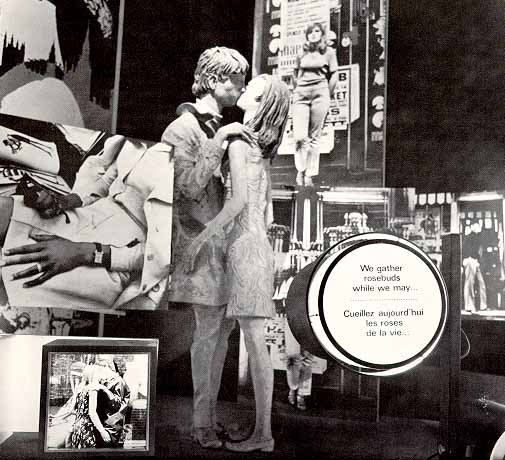 |
Britain Today featured whimsical displays of British life. The intent was to show that the British don't take anything too seriously. |
Another escalator led up to the "Industrial Britain" section, a huge Aladdin's cave of technology. A series of screens set into alcoves in the walls showed brief films on individual industries. These were surrounded by relevant models and diagrams on vertical take-off aircraft, Hovercraft, radio telescopes, nuclear power, computers and fuel cells. There were models of the Concorde aircraft, the Queen Elizabeth IV cruise liner and a 200 MPH BRM racing car.
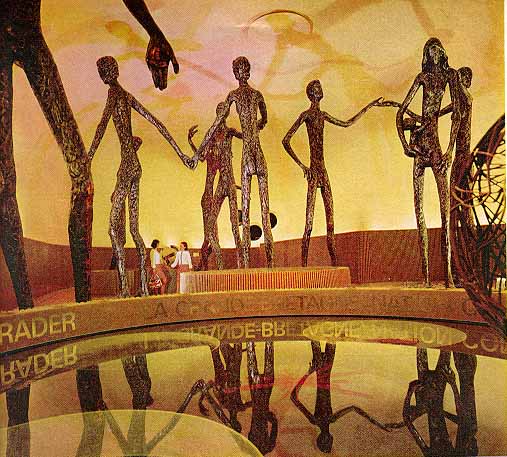 |
Britain in the World featured ten 18-foot tall aluminum nude figures by Mario Armengol. |
The final theme was "Britain in the World." Dominating the section were ten 18-foot tall aluminum nude figures by Mario Armengol. At their feet were exhibits showing the unifying influence of Britain's language, governmental systems, law and traditions on the world.
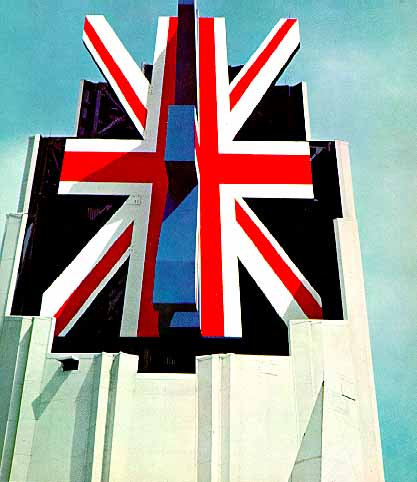 |
A three-dimensional Pop-Art Union Jack topped the pavilion's jagged tower. |